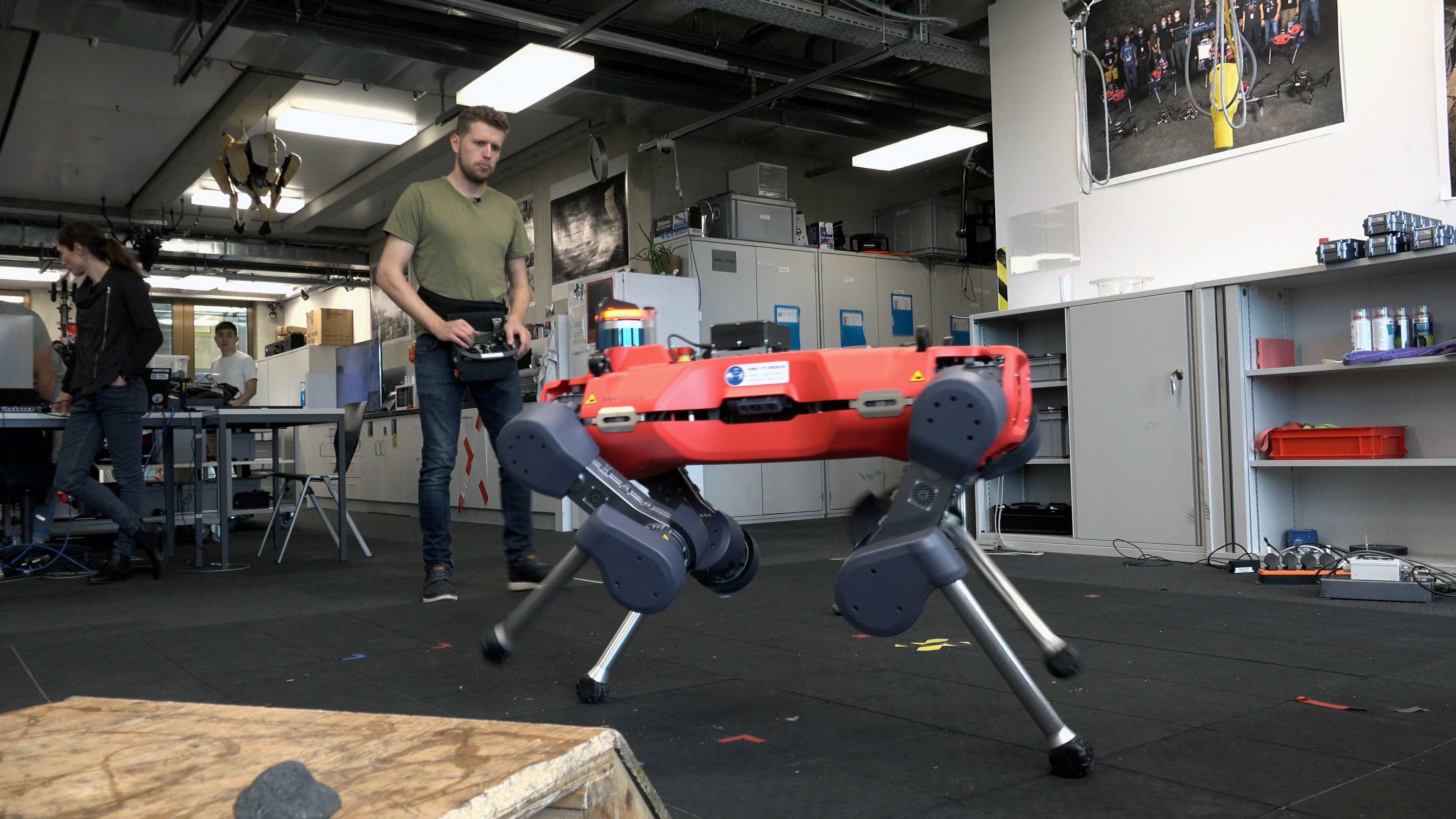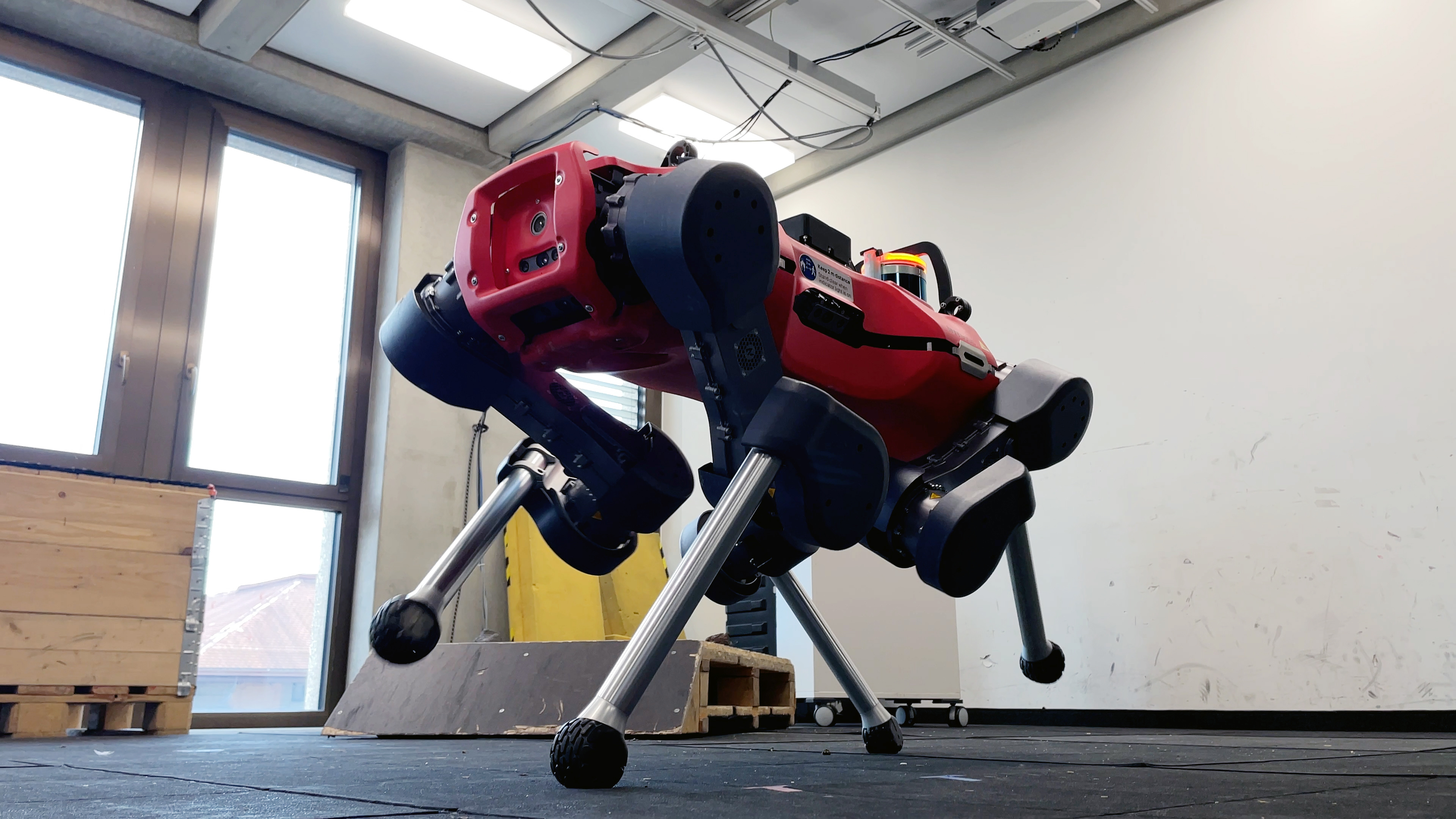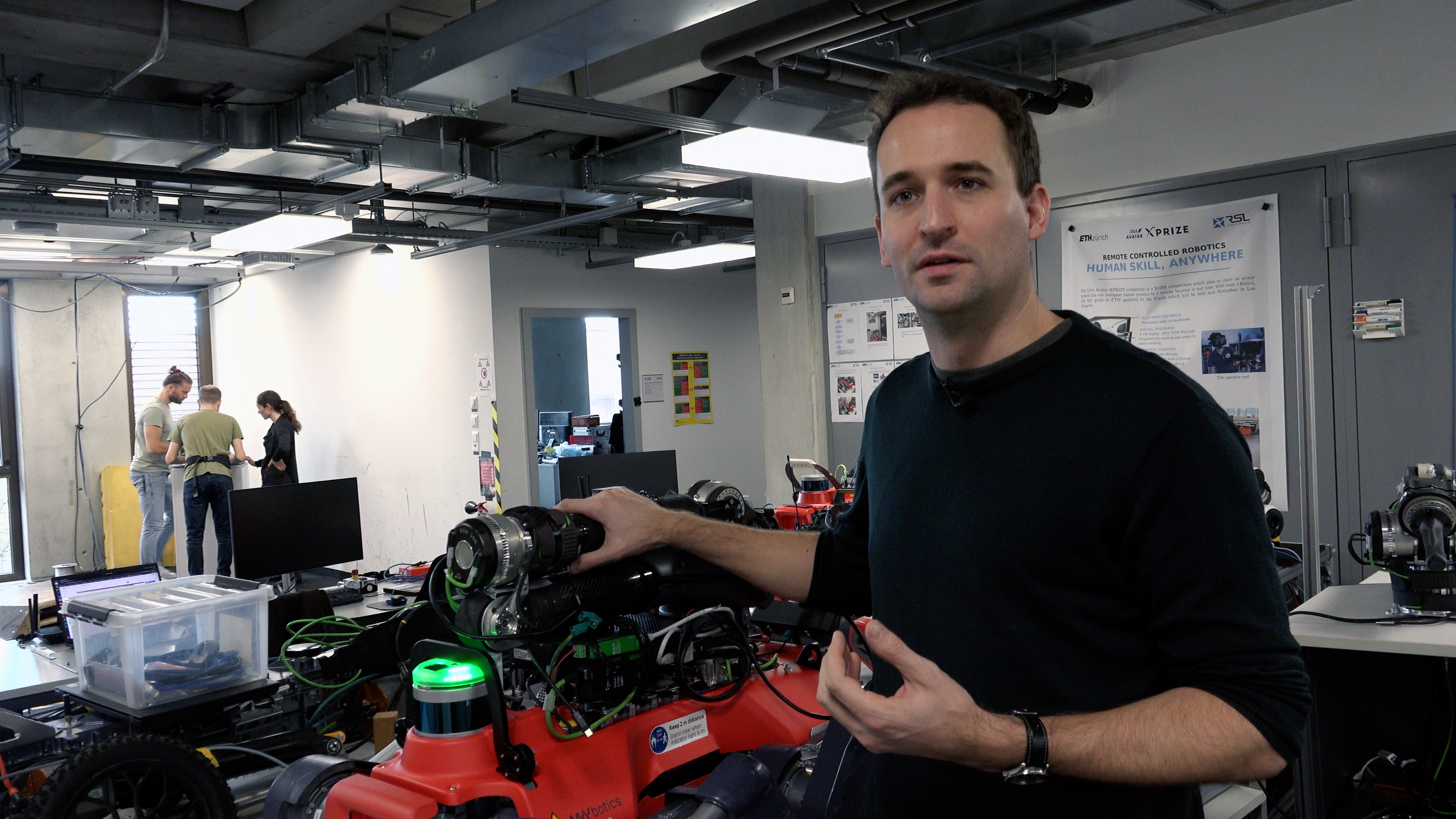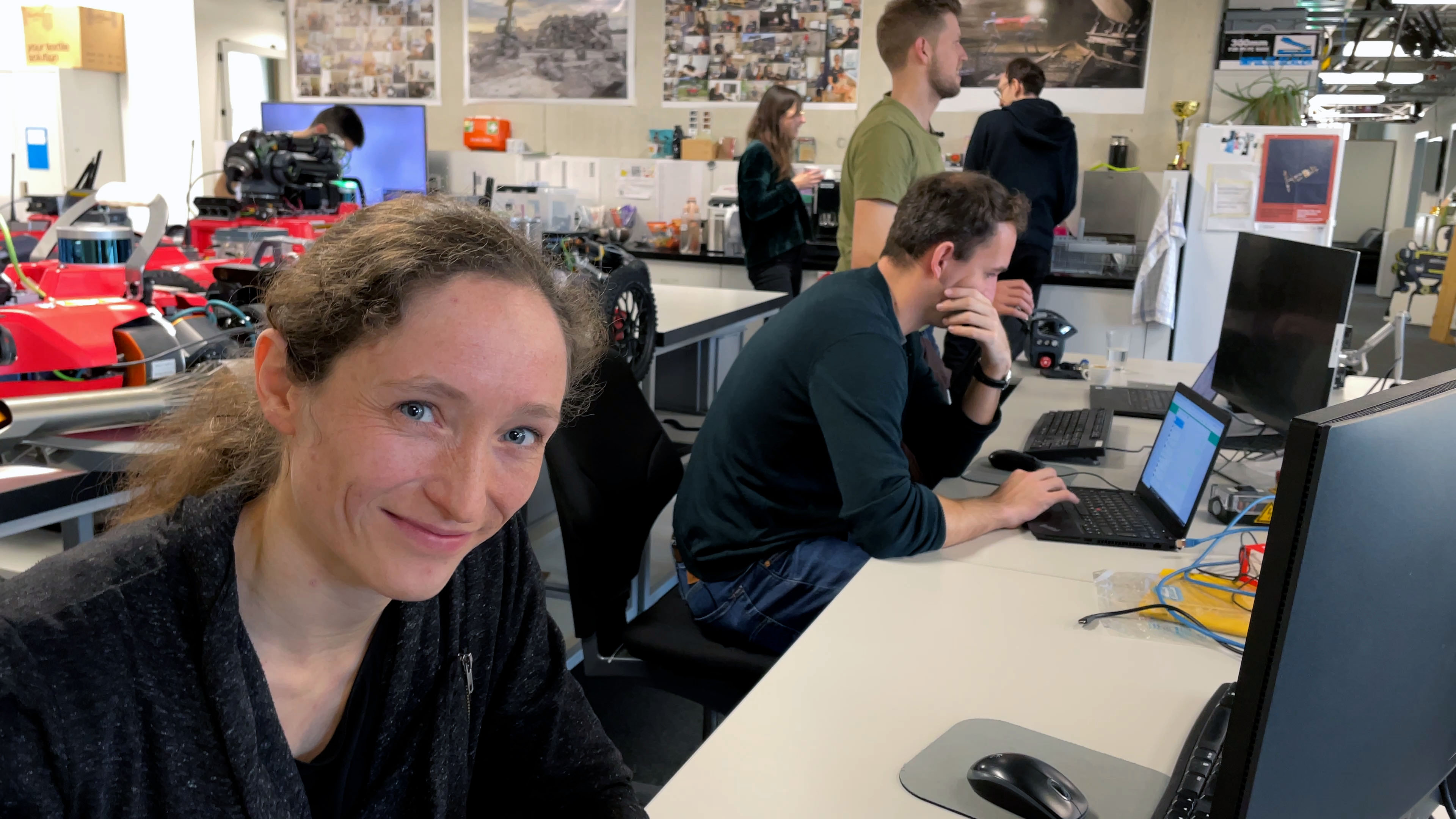
Swarm of Swiss robots could take part in future space missions

A Swiss research team has proposed using a swarm of small robots rather than a heavy rover for future missions to the moon or Mars. The advantage is obvious: if one fails, its “teammates” can take over and continue the mission according to plan. SWI swissinfo.ch visited the laboratory in Zurich.
At first the robot lies on the floor like a lazy dog. Only when researcher Philip Arm presses a button on his remote control does “Dobby” get up and start moving independently towards a wooden pallet.
This four-legged walking robot, produced by the federal technology institute ETH Zurich and named after a character from the Harry Potter books, could in the future collect important data for research on other celestial bodies.
Growing interest in the moon and Mars has sparked a veritable space race in recent years. Numerous nations – and the super-rich – are getting involved. New technologies and the economic and geopolitical interests of the participating countries play an important role.
On top of this, scientists are interested in data on geology and climate and the search for water and possible life beyond Earth. Numerous missions to the moon and Mars are currently in the planning or have been announced.
“The most interesting areas on the moon or Mars are often in craters or on very difficult terrain that can be extremely rocky or steep,” says Arm, a PhD student at ETH Zurich. “And that’s exactly where a legged robot has advantages.”
Compared to a heavy rover whose wheels can get stuck in lunar or Martian dust, a 50-kg legged robot moves much faster.
Dobby climbs a pallet with a slippery ramp with ease, and if it slips, it simply tries again. “It’s extremely difficult to get this robot to fall down at all,” Arm says with a laugh.
Teamwork for a successful mission
Having several robots in a team increases the chances of a successful mission. Some of them are generalists, while others have various specific tasks to fulfil: mapping, finding certain rocks, taking measurements and carrying out analyses. Multiple robots can do things faster, Arm says.
And if one robot in a group breaks down, its teammates can simply continue the work. “In a robot swarm, it is much easier to compensate for a failure on a mission” without having to abandon the mission, Arm adds.
The robots are produced by the same company, a spin-off of ETH Zurich called Anybotics. They are already being used in various industries, for example for inspecting railway infrastructure or in safety zones at chemical plants.
The group led by Hendrik Kolvenbach, the senior scientist at ETH Zurich’s Robotic Systems Lab where Arm conducts research, won a competition organised by the European Space AgencyExternal link in April 2023 with a small swarm of such walking robotsExternal link. The project was done in cooperation with the Forschungszentrum Informatik (Research Centre for Information Technology) in Germany and other partners in Switzerland.

Why the underside of a stone is interesting
The aim of the competition was to find and identify minerals on a test site in Luxembourg that simulates the shady polar regions of the moon. Three robots worked together and were able to convince the jury. The Swiss-German research team won a year’s funding to further develop the technology.
What was interesting about this competition was that all the successful research groups used legged robots, Kolvenbach says.

So the idea seems to be in line with a trend. German research institutes and the Deutsches Zentrum für Luft- und Raumfahrt (German Aerospace Centre) are also developing robots that can work together as a team.
The next step at ETH Zurich is to include several systems; travelling or even flying robots could work with Dobby, which would make the team even more broadly positioned for a possible mission.
In Zurich, Arm is getting the robot dog to move a lava rock with its foot to show us how Dobby could operate on the moon.
Because solar winds fiercely erode the surfaces of the moon and Mars, the underside of a stone is informative for research. It is not exposed to strong cosmic radiation, so allows much more precise analyses of the minerals in the stone than the side directly on the surface of the moon or Mars.

More
Newsletters
Researchers from a range of disciplines
The Robotic Systems Lab at ETH Zurich works on an interdisciplinary basis: classic mechanical engineering, computer science, electronics and robotics are in the mix. A dozen walking and wheeled robots are waiting on tables for tests. Kolvenbach says his team is particularly interested in challenging environments. Testing often takes place in a Swiss quarry.
Anna Mittelholz, a planetary geophysicist and member of the team, is pursuing her own project, called Lunar LeaperExternal link, with a three-legged robot named Space Hopper.

She wants to use the hopping robot to investigate a hole on the moon that is thought to have been created by the collapse of an underground lava tunnel and which could therefore connect to the tunnel.
The findings from such investigations could in future play a role in planning a base for longer human missions on the moon.
>> Find out more about this project in this video from our “Found in space” series:
Mittelholz, too, sees a clear advantage in a swarm. “Of course, it would be much easier if we could carry out measurements over a wider area and approach this hole from different sides and with different instruments,” she says.
Such a team of robots would also be an asset for documenting a mission, as they could film each other and send this video material to Earth while carrying out experiments.
On the moon or Mars, the robots would not of course be remote-controlled – they would have to work autonomously and in a network, because the delay in radio signals to Earth is between a few seconds (moon) and minutes (Mars). The robots would be recharged using solar cells.
There are also a number of factors that could affect robots far from Earth. Because there is no atmosphere, heat regulation is much more difficult, Arm says.
The higher cosmic radiation must also be taken into account, for example in the electronics. “And it’s very, very dusty, sandy and rocky where the robot has to move around,” he adds.
Long-term project
For this reason, the team working on the Dobby robot first relies on computer simulations before assembling a new system. The budget has to be considered – after all, a robot like this can quickly cost as much as a luxury car.
The laboratory raises this money primarily through international and national research grants, but also through competitions such as the one won by the ETH Zurich team last year.
The researchers are planning long-term for the swarm project. “With Dobby, we are testing technologies that will be relevant in ten to 20 years because it is a relatively large and complex system,” Arm says.
The simpler Space Hopper, on the other hand, could be hopping around on the moon in five to ten years’ time. The little three-legged robot has already passed a zero-gravity test in a so-called parabolic flight.
Meanwhile, its four-legged friend Dobby has had enough. It’s lying there lazily again – or rather, it’s having its batteries recharged – for its next test mission.
Edited by Sabrina Weiss
Adapted from German by Catherine Hickley/gw

More
In space exploration, Switzerland punches above its weight

In compliance with the JTI standards
More: SWI swissinfo.ch certified by the Journalism Trust Initiative




























You can find an overview of ongoing debates with our journalists here . Please join us!
If you want to start a conversation about a topic raised in this article or want to report factual errors, email us at english@swissinfo.ch.